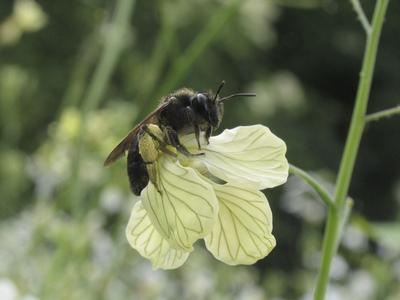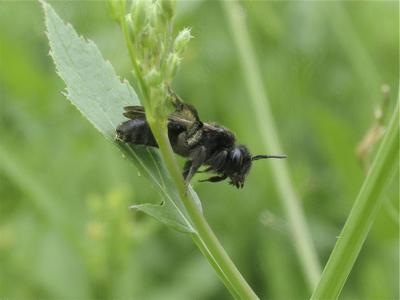 |
Andrena nigrospina female |
Worcestershire Record No. 27 November 2009 p. 23
Geoff Trevis
 |
Andrena nigrospina female |
Monitoring at Upper Blackstone Farm has continued in 2009 and some patterns seem to be emerging which confirm observations reported previously. Foraging occurs almost exclusively on wild radish Raphanus raphanistrum though early in the year before the radish was in flower females were seen on dandelion and later photographs were taken of females on hogweed Heracleum sphondylium, creeping thistle Cirsium arvense and bramble Rubus fruticosus (sensu lato). The maximum number of foraging females was always in areas sheltered from prevailing winds with only a small number being seen on the high, exposed ground even though the rich flora was available. It will be vital therefore to ensure that the sheltered areas are maintained when re-creation of heathland is begun on the site.
Identification of nest sites remains a problem as only one nest has ever been found, as previously reported. This was on higher ground than the foraging areas and would receive the maximum amount of sunshine. This year an experiment was undertaken in which a strip of ground along the field edge, where the one nest had been found, was sprayed to keep the area sparsely vegetated. Sparse vegetation appears to be another requirement of A. nigrospina so we hoped that more nests would be encouraged. Unfortunately no additional nesting was seen though it cannot be ruled out. Solitary bee nests have also been noted in many patches of bare and lightly vegetated ground but A. nigrospina has not been seen using them and they could well be the nests of other species known to be present at Upper Blackstone Farm.
 |
Andrena nigrospina male |
One idea I had was that nesting might be on the adjacent fields of the West Midlands Safari Park. Immediately opposite our land, just across the Severn Valley Railway, is the Asian ungulates enclosure and I wondered if constant grazing and trampling would have produced bare patches that might be used for nesting by A. nigrospina. With kind permission of the Safari Park manager I was given access to the enclosure. Unfortunately, though the sward was very short it was also very dense, like a well maintained lawn. It is unlikely, therefore, that it affords good nesting conditions.
Occasionally females well laden with pollen have been seen to fly to a great height when leaving the foraging areas. This may indicate that they are leaving our fields to nest at more remote sites. George Else, one of the country’s leading hymenopterists, has confirmed that A. nigrospina may fly between 1 and 2Km between its foraging site and its nesting site. If this is the case we may have considerable difficulty in tracking down the nests.
Andy Jukes has provided data about the Highgate Common bees and it has been interesting to compare this with our Upper Blackstone Farm data. Generally his information has mirrored ours in showing the need for sheltered sites with wild radish for foraging and open very sunny sites for nesting. However, nests have been located in sandy areas of Highgate Common near Wombourne in Staffordshire which superficially look very similar to parts of Devil’s Spittleful where no A. nigrospina or their nests have ever been recorded. My first impression is that the more open grassy areas on our reserve are still too overgrown to provide the necessary habitat.
One other interesting feature noted this year was the flight period. In previous years the bees were seen from mid-May to very early August, the main flowering period of the wild radish. However, in 2009 the earliest record was on 21st April, well in advance of the wild radish flowers, and the last record was 19th June making the flight period both shorter and much earlier. Again, careful monitoring will be needed in 2010.
Clearly we still have a lot to learn about the ecology of A. nigrospina and monitoring in the coming years will be essential to provide the information needed for the detailed management plans. I would be glad to hear from anybody interested in helping with this project. I am glad to acknowledge financial assistance from Hymettus so that surveyors’ expenses could be refunded but it is unlikely that money will be available in future. I would also like to thank Dave Barnett, Harry Green, Nigel Jones, Andy Jukes, Kevin McGee, Brett Westwood and Rosemary Winnall for their continuing help with this project, and Caroline Corsie for strategic treatment of the field margin with herbicide.
| WBRC Home | Worcs Record Listing by Issue | Worcs Record Listing by Subject |